The Cambridge History of Japan, Vol. 3: Medieval Japan
Подождите немного. Документ загружается.


THE PEASANTS, OVERLORD RULE, TAXATION 319
Governance
0/shoen
The rule of the
shoen
proprietor over the peasants may be divided into
three broad areas: collection of
taxes,
jurisdiction over land, and juris-
diction over criminal matters. The first category, the collection of
taxes,
has already been described. Taxes were originally collected by
shoen
officials, but once jito were installed, they usually became the tax
collectors.
29
The authority to collect taxes gave the shoen officials and
jito close personal control over the peasants. When peasants did not
pay their taxes, the proprietor would exert various types of pressure -
expressed as "delivering a reprimand" (kenseki 0 kuwaeru) - and if
that did not produce results, he would physically restrain the default-
ing peasant. This was known as "binding one's person" (ntigara 0
karametoru). In some cases, the jito would make the delinquent cultiva-
tor his genin. The jito, as tax collectors, applied physical restraint to
myoshu as well as to small cultivators and restricted their freedom of
movement. The peasants had previously had little freedom of move-
ment anyway, but if taxation became too severe and official control too
oppressive, they would often abscond. The jito would then forbid such
behavior and bind the peasants to the land, collecting taxes and labor
by force. Because this was a major cause of conflict between jito and
peasant, the legal code of the Kamakura bakufu, the goseibai
shikimoku, stipulated that once they had paid the nengu, peasants were
to be allowed freedom of movement.
30
The second area of proprietor rule, jurisdiction over land, refers to
the right to administer the land within the
shoen.
The proprietor had
the right to survey the cultivated land in the shoen in order to mea-
sure the area of land from which nengu would be exacted, reorganize
locally held peasant lands, and reassign the lands of peasants who
had fled.
Because jurisdiction over the land was an important component of
the proprietor's control, once jito were installed on shoen, severe con-
flicts arose between proprietor and jito concerning this right. Accord-
ing to a 1247 decree of the Kamakura bakufu:
There are many conflicts in which jito insist that though
nengu
must be
submitted to the
shoen
proprietor from local lands of
shoen
officials and
peasants, the right of jurisdiction over land is the jito's. Meanwhile,
shoen
29 On the various limitations on jito controlling shoen, see Yasuda Motohisa, Jito oyobi jito
ryoshusei
no kenkyu (Tokyo: Yamakawa shuppansha, 1961).
30
Goseibai
shikimoku, art. 42, in CHS, pp. 24-26.
Cambridge Histories Online © Cambridge University Press, 2008

320 THE MEDIEVAL PEASANT
officials hold that the jito's allotment fields are under his jurisdiction but that
lands in local possession
(myoden)
are under the
shoen
proprietor's. However,
"originally appointed jito" [those appointed to lands that had hadjtw before
the Jokyu disturbance] must abide by the limitations set on their rights long
ago,
and "newly appointed
jito"
are limited to one
cho
for every eleven
cho
as
allotment fields.
31
In this way the Kamakura bakufu attempted to restrain the jito's
increasing power over land jurisdiction.
Such repeated clashes between
shoen
officials and jito over matters of
land jurisdiction, as well as. over the right of jurisdiction in criminal
matters, had a decisive effect on peasant control. These were, for
instance, various ways to dispose of fields abandoned by absconding
peasants. Such fields could be allotted to other peasants or absorbed
into the jito's holdings. Or they might be given as my5 to a so-called
ronin,
someone who was not a regular resident of the shoen. Because
the disposal of such land was based on the right of jurisdiction over
land, the person who held this right had considerable authority. In
1185 Minamoto Yoritomo incurred the wrath of the aristocracy and the
religious establishment when first reporting to the emperor the installa-
tion of jito, he negotiated to be allowed to grant jito the right of
jurisdiction over land.
32
Throughout the Kamakura period, there was
nothing uniformly regarded as embodying jito authority, and so the
importance of possessing the right of jurisdiction over land cannot be
underestimated.
The right of jurisdiction in criminal matters, the third area of propri-
etor rule, combined police and judicial powers. This included the
authority to take punitive action against shoen peasants who violated
the law. In addition, it allowed the proprietor to enforce criminal
sentences, including acquiring confiscated land and property for him-
self.
According to contemporary law, in some cases the guilty party
could be driven off the shoen, his land confiscated, and his dwelling
destroyed. The right of acquiring confiscated land and property was
recognized as belonging to the person who exercised the right of crimi-
nal jurisdiction. For this reason, there was intense rivalry among
shoen
officials and jito for the right of criminal jurisdiction.
A Kamakura bakufu law of 1223 designated that items confiscated
in a criminal case were to be divided between the shoen proprietor
31 Kamakura bakufu supplementary law no. 259, in CHS, p. 162.
32 The aristocrat Kujo Kanezane of the regency house expresses his surprise over this matter in
his diary, Gyokuyo: "Not only will they impose a military rice tax, but they will also gain
complete control over the land."
Cambridge Histories Online © Cambridge University Press, 2008

THE PEASANTS, OVERLORD RULE, TAXATION 321
and the jito, with the former receiving two-thirds and the latter one-
third.
33
The jito, however, attempted to take over by force the entire
right of criminal jurisdiction. When a peasant defaulted on taxes and
absconded, the wife and children left behind were made genin. Even
in the case of a very small theft, a large penalty was often imposed.
There were many cases of penalties of unprecedented severity. In
Yamada and Befu villages in the Taniyama District of Satsuma Prov-
ince in 1300, the
71**0
and district head clashed over peasant control.
The jito invoked the right of criminal jurisdiction in forty-one sepa-
rate,
minor incidents involving peasants, such as stealing potatoes,
committing slander, killing dogs, and stealing horses. He seized the
culprits, their wives, and children and exacted overly harsh penal-
ties.
34
Such extreme enforcement of the right of criminal jurisdiction
by the jito was denounced by the peasants and shoen oficials as "new
and illegal practices" or unprecedented, illegal acts. By applying such
pressure, the jito was attempting to gain direct and personal control
over the peasants.
Jito and shoen officials competed for control of the peasants in all
three of the areas discussed: the collection of taxes and jurisdiction
over land and criminal matters. The jito attempted to monopolize local
control over the shoen's land and peasants; the shoen officials tried to
prevent the private subordination of the peasants to the jito; and the
peasants were caught in the middle of this conflict.
Peasant resistance
Control over peasants in the shoen system was divided between the
proprietor, in his ability to collect all the taxes, and the local shoen
officials and jito, in their jurisdiction over land and criminal matters.
In the fourteenth century, the peasants began to demand a reduction
in, or even an exemption from, nengu. On
shoen
near Kyoto, in many
cases even the local shoen officials united with the peasants to press
these demands on the proprietor. However, at this point the shoen
system itself had begun to decline amidst antiproprietor movements
led by
shoen
officials in league with shugo. Demands for reductions or
exemptions from taxes were due less to the peasants' inability to pay
them than to their desire to deny the proprietor's right to collect
them.
33 Kamakura bakufu supplementary law no. 14, in CHS, p. 66.
34 The judicial decree of 1300 of the Kyushu office of the Kamakura bakufu is found in Yamada
monjo.
Cambridge Histories Online © Cambridge University Press, 2008
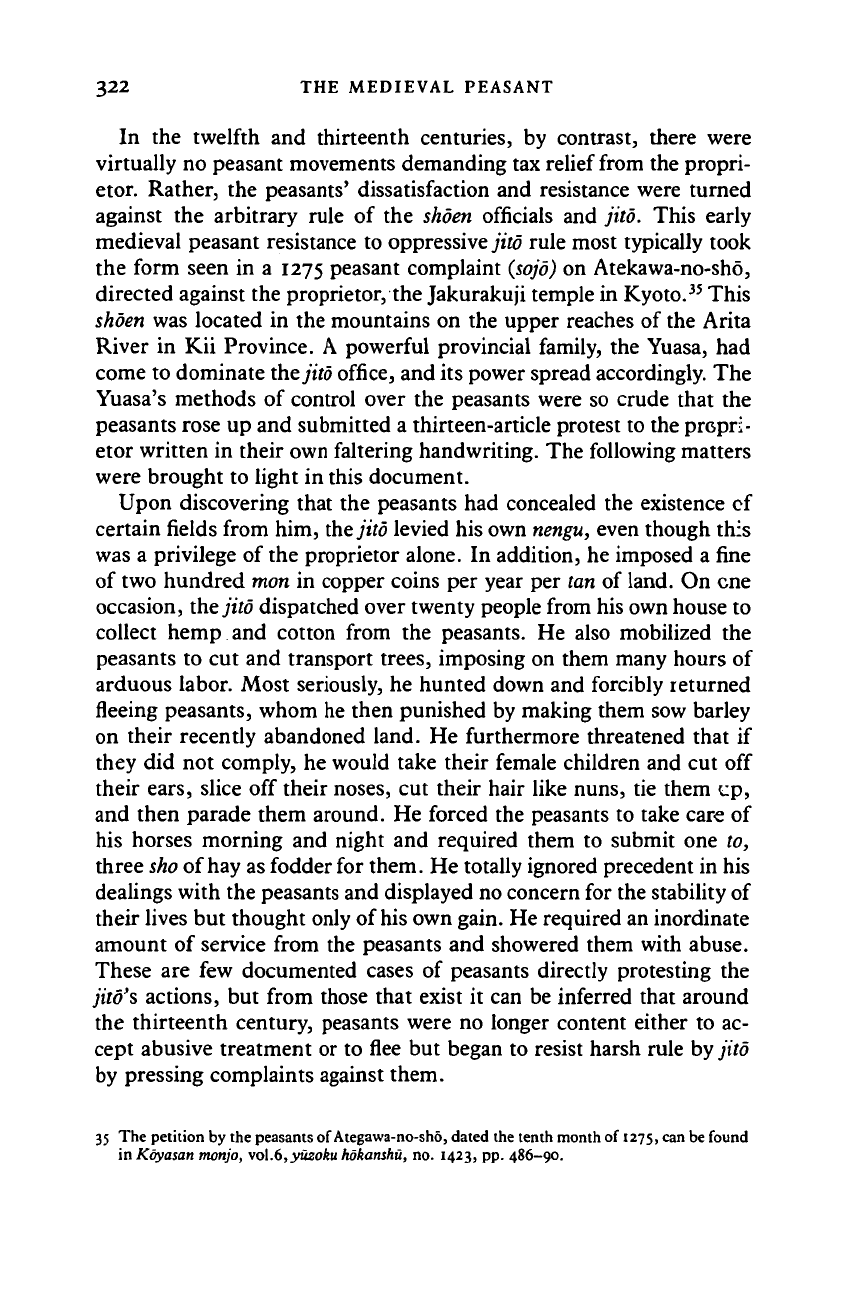
322 THE MEDIEVAL PEASANT
In the twelfth and thirteenth centuries, by contrast, there were
virtually no peasant movements demanding tax relief from the propri-
etor. Rather, the peasants' dissatisfaction and resistance were turned
against the arbitrary rule of the
shoen
officials and jito. This early
medieval peasant resistance to oppressive jito rule most typically took
the form seen in a 1275 peasant complaint
(sojo)
on Atekawa-no-sho,
directed against the proprietor, the Jakurakuji temple in Kyoto.
35
This
shoen
was located in the mountains on the upper reaches of the Arita
River in Kii Province. A powerful provincial family, the Yuasa, had
come to dominate the
jito
office, and its power spread accordingly. The
Yuasa's methods of control over the peasants were so crude that the
peasants rose up and submitted a thirteen-article protest to the propri-
etor written in their own faltering handwriting. The following matters
were brought to light in this document.
Upon discovering that the peasants had concealed the existence cf
certain fields from him, the jito levied his own
nengu,
even though this
was a privilege of the proprietor alone. In addition, he imposed a fine
of two hundred
mon
in copper coins per year per tan of land. On cne
occasion, the jito dispatched over twenty people from his own house to
collect hemp and cotton from the peasants. He also mobilized the
peasants to cut and transport trees, imposing on them many hours of
arduous labor. Most seriously, he hunted down and forcibly returned
fleeing peasants, whom he then punished by making them sow barley
on their recently abandoned land. He furthermore threatened that if
they did not comply, he would take their female children and cut off
their ears, slice off their noses, cut their hair like nuns, tie them up,
and then parade them around. He forced the peasants to take care of
his horses morning and night and required them to submit one to,
three
sho
of hay as fodder for them. He totally ignored precedent in his
dealings with the peasants and displayed no concern for the stability of
their lives but thought only of
his
own gain. He required an inordinate
amount of service from the peasants and showered them with abuse.
These are few documented cases of peasants directly protesting the
jitd's actions, but from those that exist it can be inferred that around
the thirteenth century, peasants were no longer content either to ac-
cept abusive treatment or to flee but began to resist harsh rule by jito
by pressing complaints against them.
35 The petition by the peasants of Ategawa-no-sho, dated the tenth month of 1275, can be found
in Koyasan monjo, vol.6,yuzoku
hokanshu,
no. 1423, pp. 486—90.
Cambridge Histories Online © Cambridge University Press, 2008
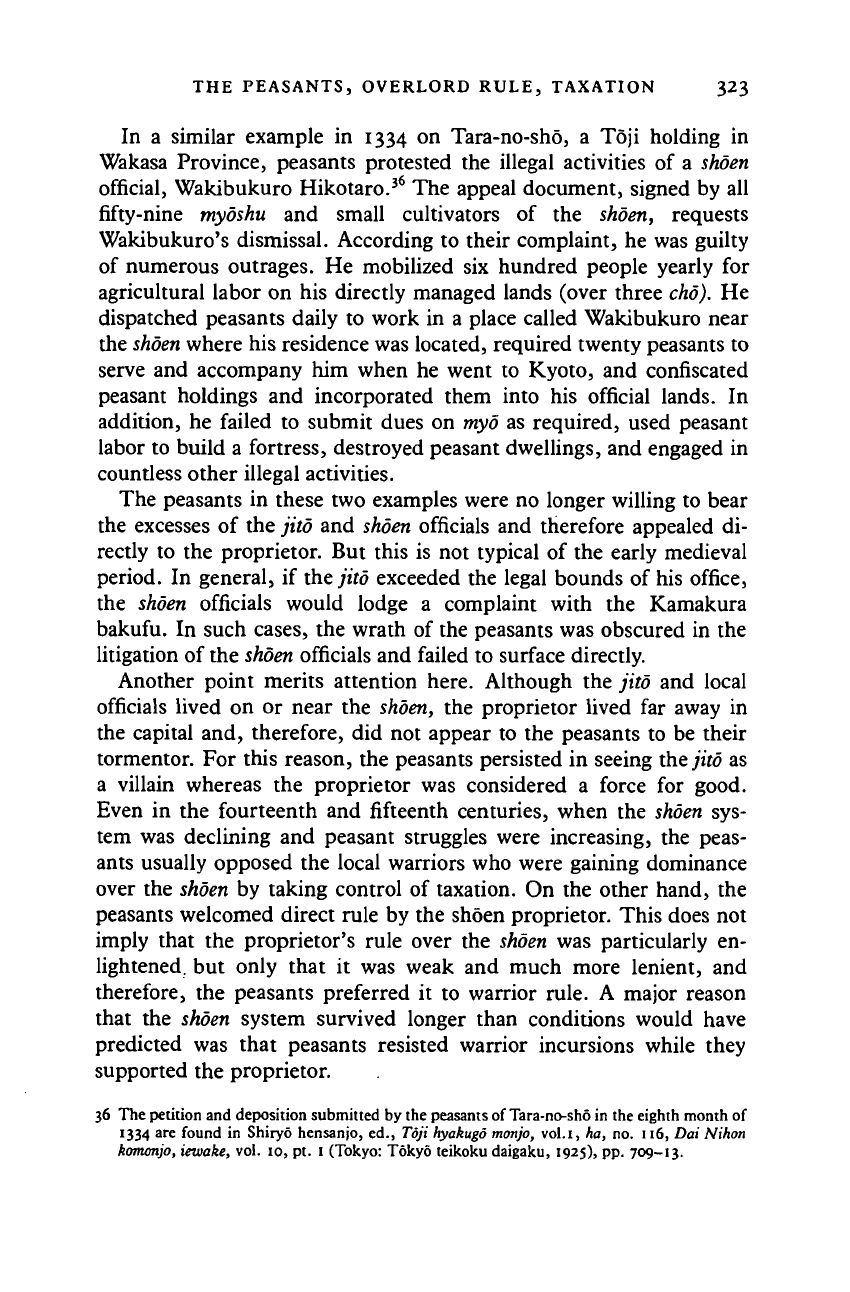
THE PEASANTS, OVERLORD RULE, TAXATION 323
In a similar example in 1334 on Tara-no-sho, a Toji holding in
Wakasa Province, peasants protested the illegal activities of a shoen
official, Wakibukuro Hikotaro.
36
The appeal document, signed by all
fifty-nine myoshu and small cultivators of the shoen, requests
Wakibukuro's dismissal. According to their complaint, he was guilty
of numerous outrages. He mobilized six hundred people yearly for
agricultural labor on his directly managed lands (over three cho). He
dispatched peasants daily to work in a place called Wakibukuro near
the
shoen
where his residence was located, required twenty peasants to
serve and accompany him when he went to Kyoto, and confiscated
peasant holdings and incorporated them into his official lands. In
addition, he failed to submit dues on myo as required, used peasant
labor to build a fortress, destroyed peasant dwellings, and engaged in
countless other illegal activities.
The peasants in these two examples were no longer willing to bear
the excesses of the jito and shoen officials and therefore appealed di-
rectly to the proprietor. But this is not typical of the early medieval
period. In general, if the;ird exceeded the legal bounds of his office,
the shoen officials would lodge a complaint with the Kamakura
bakufu. In such cases, the wrath of the peasants was obscured in the
litigation of the shoen officials and failed to surface directly.
Another point merits attention here. Although the jito and local
officials lived on or near the shoen, the proprietor lived far away in
the capital and, therefore, did not appear to the peasants to be their
tormentor. For this reason, the peasants persisted in seeing the jito as
a villain whereas the proprietor was considered a force for good.
Even in the fourteenth and fifteenth centuries, when the shoen sys-
tem was declining and peasant struggles were increasing, the peas-
ants usually opposed the local warriors who were gaining dominance
over the shoen by taking control of taxation. On the other hand, the
peasants welcomed direct rule by the shoen proprietor. This does not
imply that the proprietor's rule over the shoen was particularly en-
lightened, but only that it was weak and much more lenient, and
therefore, the peasants preferred it to warrior rule. A major reason
that the shoen system survived longer than conditions would have
predicted was that peasants resisted warrior incursions while they
supported the proprietor.
36 The petition and deposition submitted by the peasants of Tara-no-sho in the eighth month of
1334 are found in Shiryo hensanjo, ed., Toji
hyakugo
monjo,
vol.i, ha, no. 116, Dai Nihon
komonjo,
iewake, vol. io, pt. I (Tokyo: Tokyo teikoku daigaku, 1925), pp. 709-13.
Cambridge Histories Online © Cambridge University Press, 2008

324 THE MEDIEVAL PEASANT
THE ECONOMIC LIFE OF THE PEASANTS
Clothing,
food,
and shelter
There is still a dearth of research regarding specific aspects of medi-
eval peasant life, including their clothing, food, and shelter, but I shall
present a summary of what little is known to date.
Clothing.
The fabric most widely used for clothing by medieval peas-
ants was hemp or ramie
(karamushi).
Hemp was a perennial plant that
could be cultivated anywhere in Japan. The process of producing
thread from the plant was not difficult, and so it was widely used as a
component in peasant clothing. Several steps, however, were involved
in producing the fabric. The hemp stalk had to be finely shredded,
tied together, and twisted into thread. Then, it had to be placed on a
wooden stand, a pulling block, and beaten with a mallet to soften it.
This work was usually done at night during the winter season. In the
late medieval period, Echigo Province became a center of hemp pro-
duction, and a za (guild) was established there that monopolized the
production of blue hemp
(aoso).
Its guarantor was the aristocratic
Sanjonishi family. This za also produced Echigo crepe, a high-quality
product made of blue hemp, aimed at the city market.
Other fabric used for clothing included fabrics made from raw silk
thread from either cultivated or wild silkworms. Sericulture, however,
was technically quite difficult, and compared with that of hemp, the
process of making silk thread and weaving fabric was much more time-
consuming. Consequently, peasants did not commonly use silk fabric.
Silk floss and silk wadding, however, easily produced by boiling the
cocoons and then spreading them out to dry, offered good insulation
and was most often used as a winter fabric. It is known that in the
Muromachi period, silk
floss
was often among the products carried by
merchants selling in peasant markets.
37
In eastern Japan in particular,
a method known as
tsumugi
was developed, whereby silk floss was
twisted by hand into a thick thread and woven on a primitive loom
instead of being spun into raw silk thread. Because it was thick and
sturdy, this fabric provided excellent insulation. Of
all
the silk fabrics,
fabric produced in this manner was the most likely to be used by the
peasants.
37 For example, it is known that in order to sell it in local markets the merchants of Imahori
village in Omi Province kept fabric (gofukusen) from Ise in stock. See Nakamura Ken, ed.,
Imahori Hiejinja monjo (Tokyo: Yuzankaku, 1981).
Cambridge Histories Online © Cambridge University Press, 2008
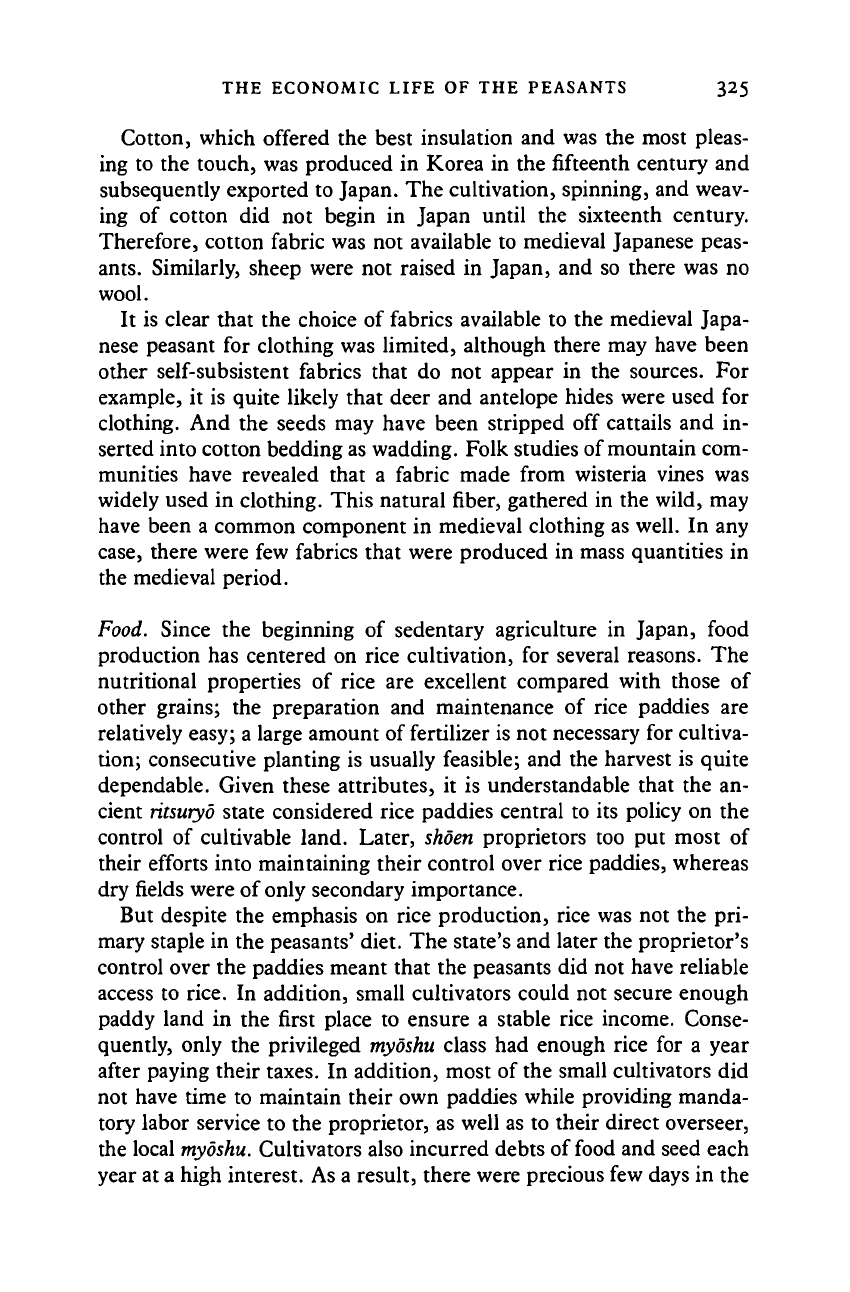
THE ECONOMIC LIFE OF THE PEASANTS 325
Cotton, which offered the best insulation and was the most pleas-
ing to the touch, was produced in Korea in the fifteenth century and
subsequently exported to Japan. The cultivation, spinning, and weav-
ing of cotton did not begin in Japan until the sixteenth century.
Therefore, cotton fabric was not available to medieval Japanese peas-
ants.
Similarly, sheep were not raised in Japan, and so there was no
wool.
It is clear that the choice of fabrics available to the medieval Japa-
nese peasant for clothing was limited, although there may have been
other self-subsistent fabrics that do not appear in the sources. For
example, it is quite likely that deer and antelope hides were used for
clothing. And the seeds may have been stripped off cattails and in-
serted into cotton bedding as wadding. Folk studies of mountain com-
munities have revealed that a fabric made from wisteria vines was
widely used in clothing. This natural fiber, gathered in the wild, may
have been a common component in medieval clothing as well. In any
case,
there were few fabrics that were produced in mass quantities in
the medieval period.
Food.
Since the beginning of sedentary agriculture in Japan, food
production has centered on rice cultivation, for several reasons. The
nutritional properties of rice are excellent compared with those of
other grains; the preparation and maintenance of rice paddies are
relatively easy; a large amount of fertilizer is not necessary for cultiva-
tion; consecutive planting is usually feasible; and the harvest is quite
dependable. Given these attributes, it is understandable that the an-
cient ritsuryo state considered rice paddies central to its policy on the
control of cultivable land. Later, shoen proprietors too put most of
their efforts into maintaining their control over rice paddies, whereas
dry fields were of only secondary importance.
But despite the emphasis on rice production, rice was not the pri-
mary staple in the peasants' diet. The state's and later the proprietor's
control over the paddies meant that the peasants did not have reliable
access to rice. In addition, small cultivators could not secure enough
paddy land in the first place to ensure a stable rice income. Conse-
quently, only the privileged myoshu class had enough rice for a year
after paying their taxes. In addition, most of the small cultivators did
not have time to maintain their own paddies while providing manda-
tory labor service to the proprietor, as well as to their direct overseer,
the local myoshu. Cultivators also incurred debts of food and seed each
year at a high interest. As a result, there were precious few days in the
Cambridge Histories Online © Cambridge University Press, 2008
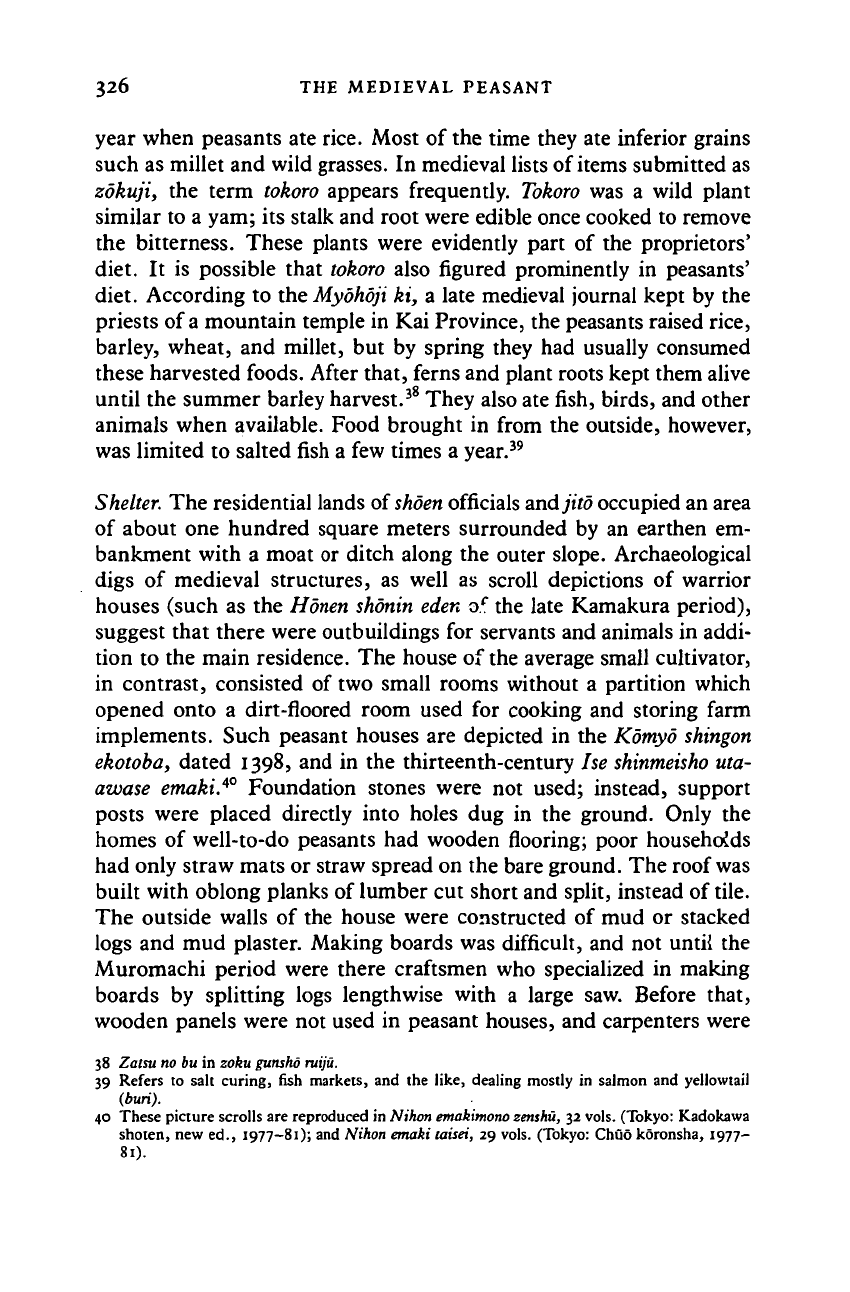
326 THE MEDIEVAL PEASANT
year when peasants ate rice. Most of the time they ate inferior grains
such as millet and wild grasses. In medieval lists of
items
submitted as
zokuji, the term
tokoro
appears frequently.
Tokoro
was a wild plant
similar to a yam; its stalk and root were edible once cooked to remove
the bitterness. These plants were evidently part of the proprietors'
diet. It is possible that
tokoro
also figured prominently in peasants'
diet. According to the
Myohoji
ki, a late medieval journal kept by the
priests of
a
mountain temple in Kai Province, the peasants raised rice,
barley, wheat, and millet, but by spring they had usually consumed
these harvested foods. After that, ferns and plant roots kept them alive
until the summer barley harvest.
38
They also ate fish, birds, and other
animals when available. Food brought in from the outside, however,
was limited to salted fish a few times a year.
39
Shelter.
The residential lands of
shorn
officials and jitd occupied an area
of about one hundred square meters surrounded by an earthen em-
bankment with a moat or ditch along the outer slope. Archaeological
digs of medieval structures, as well as scroll depictions of warrior
houses (such as the
Honen shonin eden
of the late Kamakura period),
suggest that there were outbuildings for servants and animals in addi-
tion to the main residence. The house of the average small cultivator,
in contrast, consisted of two small rooms without a partition which
opened onto a dirt-floored room used for cooking and storing farm
implements. Such peasant houses are depicted in the
Komyo shingon
ekotoba,
dated 1398, and in the thirteenth-century he
shinmeisho
uta-
azvase
emaki.
40
Foundation stones were not used; instead, support
posts were placed directly into holes dug in the ground. Only the
homes of well-to-do peasants had wooden flooring; poor households
had only straw mats or straw spread on the bare ground. The roof
was
built with oblong planks of lumber cut short and split, instead of tile.
The outside walls of the house were constructed of mud or stacked
logs and mud plaster. Making boards was difficult, and not until the
Muromachi period were there craftsmen who specialized in making
boards by splitting logs lengthwise with a large saw. Before that,
wooden panels were not used in peasant houses, and carpenters were
38 Zatsu no bu in zoku
gunslw
ruiju.
39 Refers to salt curing, fish markets, and the like, dealing mostly in salmon and yellowtail
(bun).
40 These picture scrolls are reproduced in Nihon
emakimono
zenshu,
32 vols. (Tokyo: Kadokawa
shoten, new ed., 1977-81); and Nihon emaki laisei, 29 vols. (Tokyo: Chud koronsha, 1977-
81).
Cambridge Histories Online © Cambridge University Press, 2008
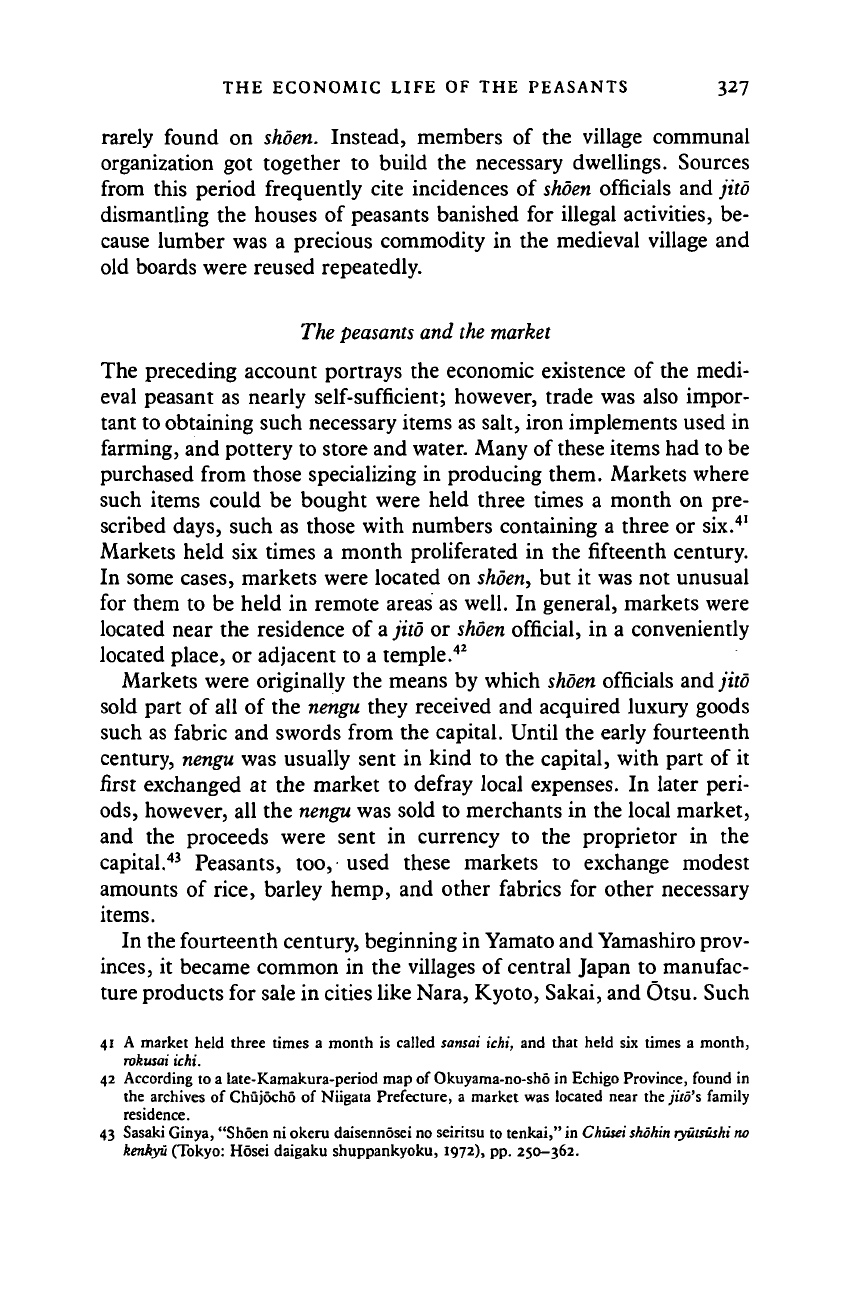
THE ECONOMIC LIFE OF THE PEASANTS 327
rarely found on shoen. Instead, members of the village communal
organization got together to build the necessary dwellings. Sources
from this period frequently cite incidences of
shoen
officials and jito
dismantling the houses of peasants banished for illegal activities, be-
cause lumber was a precious commodity in the medieval village and
old boards were reused repeatedly.
The peasants and the market
The preceding account portrays the economic existence of the medi-
eval peasant as nearly self-sufficient; however, trade was also impor-
tant to obtaining such necessary items as salt, iron implements used in
farming, and pottery to store and water. Many of these items had to be
purchased from those specializing in producing them. Markets where
such items could be bought were held three times a month on pre-
scribed days, such as those with numbers containing a three or six.
41
Markets held six times a month proliferated in the fifteenth century.
In some cases, markets were located on shoen, but it was not unusual
for them to be held in remote areas as well. In general, markets were
located near the residence of a jito or shoen official, in a conveniently
located place, or adjacent to a temple.
42
Markets were originally the means by which shoen officials and jito
sold part of all of the nengu they received and acquired luxury goods
such as fabric and swords from the capital. Until the early fourteenth
century, nengu was usually sent in kind to the capital, with part of it
first exchanged at the market to defray local expenses. In later peri-
ods,
however, all the nengu was sold to merchants in the local market,
and the proceeds were sent in currency to the proprietor in the
capital.
43
Peasants, too, used these markets to exchange modest
amounts of rice, barley hemp, and other fabrics for other necessary
items.
In the fourteenth century, beginning in Yamato and Yamashiro prov-
inces,
it became common in the villages of central Japan to manufac-
ture products for sale in cities like Nara, Kyoto, Sakai, and Otsu. Such
41 A market held three times a month is called sansai ichi, and that held six times a month,
rokusai
ichi.
42 According to a late-Kamakura-period map of Okuyama-no-sho in Echigo Province, found in
the archives of Chujocho of Niigata Prefecture, a market was located near the jito's family
residence.
43 Sasaki Ginya, "Shoen ni okeru daisennosei no seiritsu to tenkai," in
Chusei shohin tyutsushi no
kenkyu
(Tokyo: Hosei daigaku shuppankyoku, 1972), pp. 250-362.
Cambridge Histories Online © Cambridge University Press, 2008
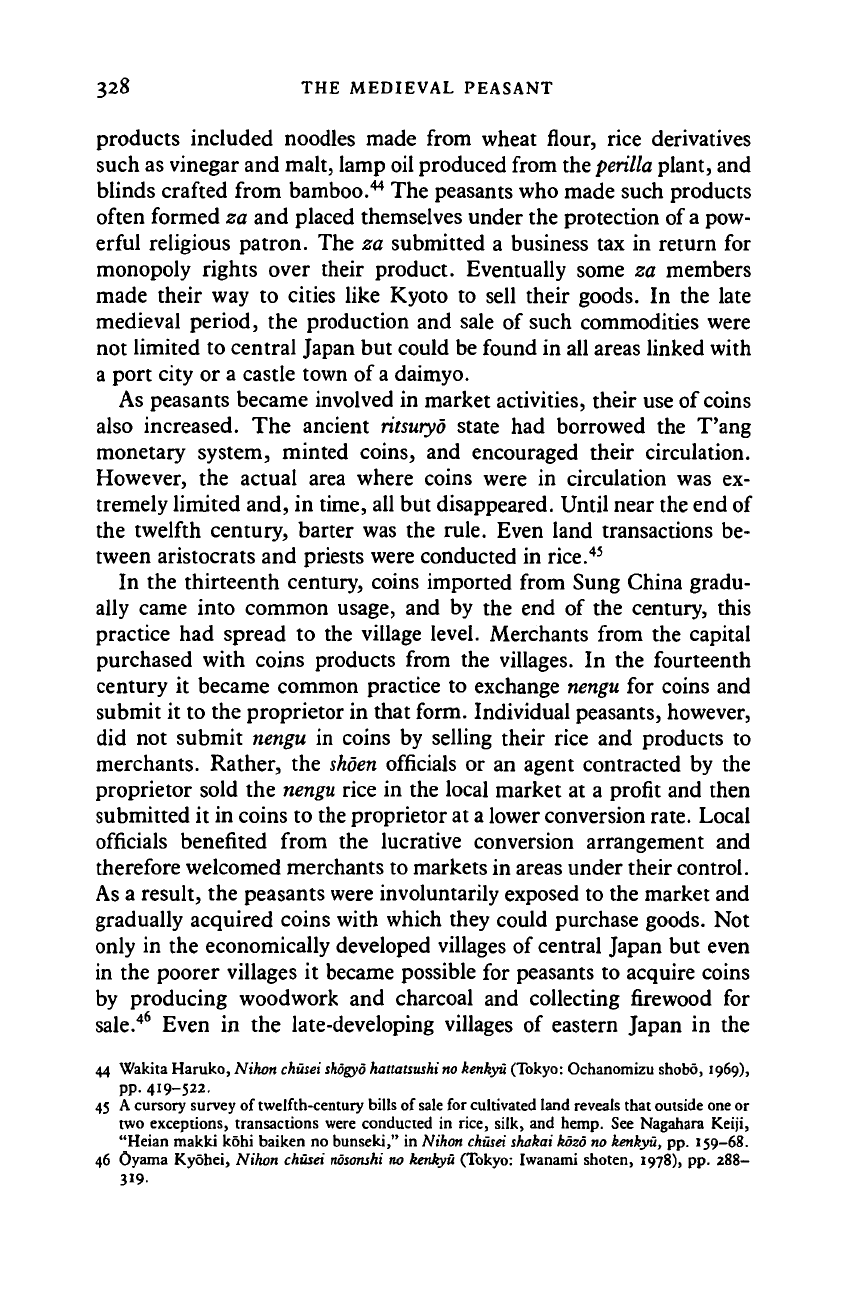
328 THE MEDIEVAL PEASANT
products included noodles made from wheat flour, rice derivatives
such as vinegar and malt, lamp oil produced from the
perilla
plant, and
blinds crafted from bamboo.
44
The peasants who made such products
often formed za and placed themselves under the protection of
a
pow-
erful religious patron. The za submitted a business tax in return for
monopoly rights over their product. Eventually some za members
made their way to cities like Kyoto to sell their goods. In the late
medieval period, the production and sale of such commodities were
not limited to central Japan but could be found in all areas linked with
a port city or a castle town of
a
daimyo.
As peasants became involved in market activities, their use of coins
also increased. The ancient
ritsuryo
state had borrowed the T'ang
monetary system, minted coins, and encouraged their circulation.
However, the actual area where coins were in circulation was ex-
tremely limited and, in time, all but disappeared. Until near the end of
the twelfth century, barter was the rule. Even land transactions be-
tween aristocrats and priests were conducted in rice.
45
In the thirteenth century, coins imported from Sung China gradu-
ally came into common usage, and by the end of the century, this
practice had spread to the village level. Merchants from the capital
purchased with coins products from the villages. In the fourteenth
century it became common practice to exchange
nengu
for coins and
submit it to the proprietor in that form. Individual peasants, however,
did not submit nengu in coins by selling their rice and products to
merchants. Rather, the
shoen
officials or an agent contracted by the
proprietor sold the
nengu
rice in the local market at a profit and then
submitted it in coins to the proprietor at
a
lower conversion
rate.
Local
officials benefited from the lucrative conversion arrangement and
therefore welcomed merchants to markets in areas under their control.
As a result, the peasants were involuntarily exposed to the market and
gradually acquired coins with which they could purchase goods. Not
only in the economically developed villages of central Japan but even
in the poorer villages it became possible for peasants to acquire coins
by producing woodwork and charcoal and collecting firewood for
sale.
46
Even in the late-developing villages of eastern Japan in the
44 Wakita Haruko, Nihon chusei
shogyo
hattatsushi
no
kenkyii (Tokyo: Ochanomizu shobo, 1969),
pp.
419-522.
45 A cursory survey of twelfth-century bills of sale for cultivated land reveals that outside one or
two exceptions, transactions were conducted in rice, silk, and hemp. See Nagahara Keiji,
"Heian makki kohi baiken no bunseki," in Nihon
chusei
shakai kdzo no kenkyii, pp. 159-68.
46 Oyama Kyohei, Nikon chusei
nosonshi
no kenkyii (Tokyo: Iwanami shoten, 1978), pp. 288-
319-
Cambridge Histories Online © Cambridge University Press, 2008
